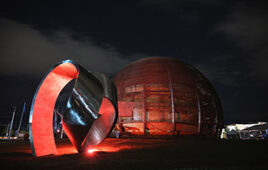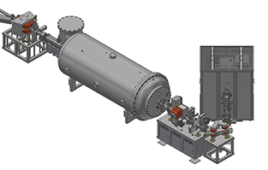 A novel class of materials that enable a safer, cheaper and more energy-efficient process for removing greenhouse gas from power plant emissions has been developed by a multi-institution team of researchers. The approach could be an important advance in carbon capture and sequestration (CCS).
A novel class of materials that enable a safer, cheaper and more energy-efficient process for removing greenhouse gas from power plant emissions has been developed by a multi-institution team of researchers. The approach could be an important advance in carbon capture and sequestration (CCS).
The team, led by scientists from Harvard Univ. and Lawrence Livermore National Laboratory, employed a microfluidic assembly technique to produce microcapsules that contain liquid sorbents encased in highly permeable polymer shells. They have significant performance advantages over the carbon-absorbing materials used in current CCS technology.
The work is described in a paper published online in Nature Communications.
“Microcapsules have been used in a variety of applications–for example, in pharmaceuticals, food flavoring, cosmetics and agriculture–for controlled delivery and release, but this is one of the first demonstrations of this approach for controlled capture,” says Jennifer A. Lewis, the Hansjörg Wyss Professor of Biologically Inspired Engineering at the Harvard School of Engineering and Applied Sciences (SEAS) and a co-lead author. Lewis is also a core faculty member of the Wyss Institute for Biologically Inspired Engineering at Harvard.
Power generating plants are the single largest source of carbon dioxide (CO2), a greenhouse gas that traps heat and makes the planet warmer. According to the U.S. Environmental Protection Agency, coal- and natural gas-fired plants were responsible for one-third of U.S. greenhouse gas emissions in 2012.
That’s why the agency has proposed rules mandating dramatically reduced carbon emissions at all new fossil fuel-fired power plants. Satisfying the new standards will require operators to equip plants with carbon-trapping technology.
Current carbon capture technology uses caustic amine-based solvents to separate CO2 from the flue gas escaping a facility’s smokestacks. But state-of-the-art processes are expensive, result in a significant reduction in a power plant’s output, and yield toxic byproducts. The new technique employs an abundant and environmentally benign sorbent: sodium carbonate, a.k.a. kitchen-grade baking soda. The microencapsulated carbon sorbents (MECS) achieve an order-of-magnitude increase in CO2 absorption rates compared to sorbents currently used in carbon capture. Another advantage: amines break down over time, while carbonates have a virtually limitless shelf life.
“MECS provide a new way to capture carbon with fewer environmental issues,” says Roger D. Aines, leader of the fuel cycle innovations program at Lawrence Livermore National Laboratory (LLNL) and a co-lead author. “Capturing the world’s carbon emissions is a huge job; we need technology that can be applied to many kinds of carbon dioxide sources with the public’s full confidence in the safety and sustainability.”
Researchers at LLNL and the U.S. Dept. of Energy (DOE)’s National Energy Technology Lab are now working on enhancements to the capture process to bring the technology to scale.
The emission-scrubbing potential of CCS is not limited to the electric generation sector; Aines says that the MECS-based approach can also be tailored to industrial processes like steel and cement production, significant greenhouse gas sources.
“These permeable silicone beads could be a ‘sliced-bread’ breakthrough for CO2 capture–efficient, easy-to-handle, minimal waste, and cheap to make,” says Stuart Haszeldine, professor of carbon capture and storage at the University of Edinburgh, who was not involved in the research. “Durable, safe, and secure capsules containing solvents tailored to diverse applications can place CO2 capture for CCS firmly onto the cost-reduction pathway.”
MECS are produced using a double capillary device in which the flow rates of three fluids–a carbonate solution combined with a catalyst for enhanced CO2 absorption, a photocurable silicone that forms the capsule shell, and an aqueous solution–can be independently controlled.
“Encapsulation allows you to combine the advantages of solid capture media and liquid capture media in the same platform,” says Lewis. “It is also quite flexible, in that both the core and shell chemistries can be independently modified and optimized.”
“This innovative gas separation platform provides large surface areas while eliminating a number of operational issues including corrosion, evaporative losses, and fouling,” notes Ah-Hyung (Alissa) Park, chair in applied climate science and associate professor of Earth and environmental engineering at Columbia Univ., who was not involved in the research.
Lewis has previously conducted groundbreaking research in the 3D printing of functional materials, including tissue constructs with embedded vasculature, lithium-ion microbatteries, and ultra-lightweight carbon-fiber epoxy materials.
Source: Harvard Univ.




